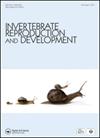Oberon®对黑腹果蝇蛹的局部生物测定:对卵巢蛋白、表皮碳氢化合物和性行为的延迟影响
IF 0.8
4区 生物学
Q4 REPRODUCTIVE BIOLOGY
引用次数: 2
摘要
摘要Spiromesifen(Oberon®240 SC;浓缩溶液;德国拜耳作物科学公司)是一种来源于螺环四烯酸的农药,主要通过乙酰辅酶a羧化酶阻断脂质生物合成。然而,其行动方式需要进一步分析。本研究旨在评价螺甲西芬对果蝇的亚致死作用。用两种浓度(LD10=21.45和LD25=39.53μg/蛹)对新蜕皮蛹进行了处理,结果表明,处理对幼虫和蛹的发育期没有显著影响。然而,螺甲西芬对从处理过的蛹中存活下来的苍蝇造成了延迟作用。Spiromesifen被发现显著降低卵巢的形态计量学测量和蛋白质含量。卵巢的蛋白质模式显示,通过卵黄发生影响后代的蛋白质带数量减少。最后,与对照组相比,螺甲西芬显著降低了接受治疗的女性和男性成年人的一些表皮碳氢化合物的含量。因此,由于表皮碳氢化合物的变化,他们的性行为也受到了影响。我们的研究为干扰脂质代谢的多重影响和生理后果带来了新的见解。本文章由计算机程序翻译,如有差异,请以英文原文为准。
Topical bioassay of Oberon® on Drosophila melanogaster pupae: delayed effects on ovarian proteins, cuticular hydrocarbons and sexual behaviour
ABSTRACT Spiromesifen (Oberon® 240 SC; concentrated solution; Bayer CropScience, Germany) a pesticide derived from spirocyclic tetronic acids, acts mainly though blocking lipid biosynthesis via acetyl-CoA carboxylase. However, its mode of action requires further analyses. This study aims to evaluate the sublethal effects of spiromesifen on the fruit fly Drosophila melanogaster. The treatment was carried out by topical application on newly moulted pupae using two concentrations (LD10 = 21.45 and LD25 = 39.53 μg a.i./pupa). Our results showed that the developmental duration of larvae and pupae were not significantly affected by treatment. However, spiromesifen caused delayed effects on flies that survived from treated pupae. Spiromesifen was found to decrease significantly both the morphometric measurements and the protein contents of ovaries. The protein pattern of ovaries showed a reduction in the number of protein bands affecting the progeny via vitellogenesis. Finally, compared to controls, spiromesifen decreased significantly the amounts of some cuticular hydrocarbons in treated female and male adults. Consequently, in response to the changes in cuticular hydrocarbons, their sexual behaviour was also affected. Our study brings new insights about the multiple effects and physiological consequences of disturbing lipid metabolism.
求助全文
通过发布文献求助,成功后即可免费获取论文全文。
去求助
来源期刊
CiteScore
1.90
自引率
0.00%
发文量
21
审稿时长
>12 weeks
期刊介绍:
Invertebrate Reproduction & Development ( IRD) presents original research on the reproductive and developmental biology of the Invertebrata, both embryonic and postembryonic. IRD welcomes papers reporting significant results obtained using new techniques. Encouraged topic areas include: aquaculture, physiology, biochemistry, functional morphology, phylogeny, behavioural and regulatory mechanisms, including genetic, endocrine and molecular studies. Papers containing qualitative descriptions of reproductive cycles and gametogenesis will not be considered. IRD is published in association with the International Society of Invertebrate Reproduction and Development.

 求助内容:
求助内容: 应助结果提醒方式:
应助结果提醒方式:


